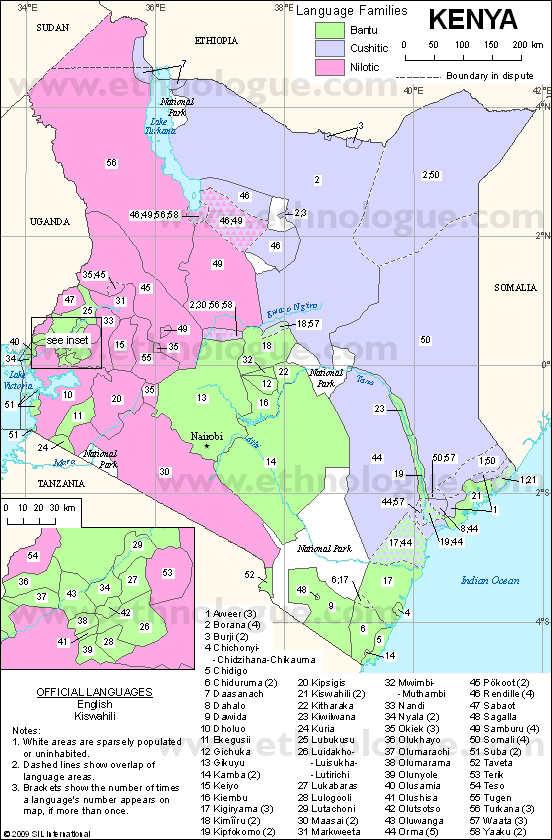|
|
Culture
Ethnic groups & languages

Languages of Kenya. Source: Ethnologue
The different ethnic groups or tribes in Kenya may be grouped in three linguistic classes: Bantus, Cushites and Nilotes/Paranilotes. Bantus comprise 65% of the population, Cushites are 3-4% and Nilotes/Paranilotes around 30-31%.
Each of these classes may be subdivided according to dialect groups, as shown in the table below. Bantus are classified as Western, Central and Coastal. The Paranilotic languages in Kenya are divided in three groups: Teso, Maasai and Kalenjin. The only Nilotic language currently spoken in Kenya is Luo. The Nilotic languages, also spoken in Sudan, Uganda and Tanzania, belong to the family of Nilo-Saharian languages. Finally, Cushites are mainly shepherds speaking Somali or Galla, languages that belong to the Afro-Asian family of tongues that originated in northern Africa and the Middle East.
The Swahili-speaking peoples are grouped in a different category, though their origin is basically Bantu. On the other hand, a separate group includes some hunter-gatherer tribes of ancient origin, today practically extinct.
|
Hunters-gatherers
|
Boni, Dahalo, El-Molo, Ndorobo/Dorobo, Sanye
|
|
Bantus
|
Western
|
Abaluhyia/Luhya, Kisii, Kuria, Gusii
|
|
Central
|
Kikuyu, Kamba/Akamba/Wa-kamba, Meru, Embu, Tharaka, Mbere
|
|
Coastal
|
Mijikenda (Digo, Duruma, Rabai, Ribe, Kambe, Jibana, Chonyi, Giriama, Kauma), Taveta, Pokomo, Taita
|
|
Nilotes-paranilotes
|
Nilotes
|
Luo
|
|
Teso
|
Iteso, Turkana
|
|
Maasai
|
Maasai, Samburu, Njemps
|
|
Kalenjin
|
Nandi, Kipsigis, Elgeyo, Sabaot, Marakwet, Tugen, Terik, Pokot
|
|
Cushites
|
Somali, Rendille, Galla, Borana/Boran, Gabbra, Orma, Sakuye
|
|
Swahili
|
Bajun, Pate, Mvita, Vumba, Ozi, Fundi, Siyu, Shela, Amu
|
|
Others
|
Europeans, Asians (Hindus, Pakistanis), Arabs
|
Religions
The major religions coexist in Kenya with the native beliefs. This cohabitation not only shows up within communities or villages, but even in a single person. The individual spirituality is sometimes a blend of elements from different cults, in a way that any of the religions adopts a unique character in Kenya. Other consequence of this is the difficulty to establish percentages for each of the religions, reason why different sources are usually not unanimous. To the dislike of statisticians, adding the rates for each religion often results in more than 100%.
Christian religion was brought by European missionaries that started settling in the country during the 19th century. Conversion works were developed in parallel with health and education, resulting in the fact that christian religion expanded in a similar extent to schools and medical care. Due to the English influence, christian Kenyans are mostly protestant, between 30 and 45% of the population, whereas 20-33% of Kenyans are catholic. In addition there are other minority groups, such as adventists, quakers and Jehova's witnesses. Christian beliefs are sometimes complemented with traditional rites, giving birth to liturgies that may seem a bit heterodox from the westerner's point of view.
Currently, the christian Churches keep a solid presence in Kenya's public life. The Church-State relationship is double faced: the government has always avoided frontal clashes with the Church, but the independent and accusatory attitude of the priests leads in occasions to a latent tension that results in the prohibition of certain religious publications. On the other hand, missions are strongly rooted in the life of rural communities. It is truly meaningful that, in many villages, the most solid and apparent building is a church belonging to any of the christian faiths.
Native beliefs, based on animism and magic, persist in the deep tribal spirit, but their expression has been reduced to the individual or family level. However, traditional beliefs still direct the tribes' social structures, their habits, rites and dances. Circumcision of children or youngsters is a usual practice. Fortunately the brutal and humiliating female equivalent is illegal and is now reduced, but it is still strongly rooted in some tribes' beliefs. Finally, magic ceremonies, initiation rites and oaths that used to sprout within secret societies, its most famous expression being the Mau-Mau in the past century, sporadically do still arise upon ethnic violence outbreaks.
Islam is the oldest of the main religions in Kenya, since it began to spread with the arrival of the first Arabs from the year 500 A.D. Today, the islamic community in Kenya comprises 5-30% of the population, mainly at the Swahili Indian Ocean coast, but also in the north and northeast regions inhabited by Somalis, where mosques coexist with churches. Most of Kenyan muslims are sunnites. The shiite minority is represented mainly by Kenyans of Pakistani origin whose grandparents arrived to the coast at the end of the 19th century or beginning of the 20th to work in the construction of the Lunatic Express Nairobi-Mombasa railway, the great communication artery around which Kenya was formed. The moderate ismailite branch, led by Aga Khan, also has some adepts. Fundamentalism is aggregated around the Islamic Party of Kenya, based on the coast and still a minority.
Hinduism, in its diverse varieties, predominates in the Indian minority. Same as Pakistanis, Hindus arrived to Kenya as workers serving the British Empire for the railway works. Those who survived the harsh labour settled in the large cities, especially in Nairobi and the coast, thriving to become one of the wealthiest communities in Kenya.
|
|



